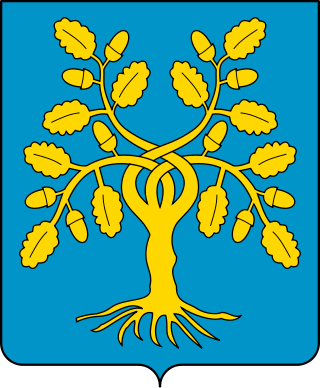
The House of Della Rovere was a powerful Italian noble family. It had humble origins in Savona, in Liguria, and acquired power and influence through nepotism and ambitious marriages arranged by two Della Rovere popes: Francesco Della Rovere, who ruled as Sixtus IV from 1471 to 1484 and his nephew Giuliano, who became Julius II in 1503. Sixtus IV built the Sistine Chapel, which was named after him. Julius II was patron to Michelangelo, Raphael and many other Renaissance artists and started the modern rebuilt of St. Peter's Basilica. Also the Basilica of San Pietro in Vincoli in Rome was the family church of the Della Rovere. Members of the family were influential in the Church of Rome, and as dukes of Urbino, dukes of Sora and lords of Senigallia; the title of Urbino was extinguished with the death of Francesco Maria II in 1631, and the family died out with the death of his granddaughter Vittoria, Grand Duchess of Tuscany.

The Camerlengo of the Holy Roman Church is an office of the papal household that administers the property and revenues of the Holy See. Formerly, his responsibilities included the fiscal administration of the Patrimony of Saint Peter. As regulated in the apostolic constitution Pastor bonus of 1988, the Camerlengo is always a cardinal, though this was not the case prior to the 15th century. His heraldic arms are ornamented with two keys – one gold, one silver – in saltire, surmounted by an ombrellino, a canopy or umbrella of alternating red and yellow stripes. These also form part of the coat of arms of the Holy See during a papal interregnum. The Camerlengo has been Kevin Farrell since his appointment by Pope Francis on 14 February 2019. The Vice Camerlengo has been Archbishop Ilson de Jesus Montanari since 1 May 2020.

The Secretary of State of His Holiness, known as the Cardinal Secretary of State, presides over the Holy See's Secretariat of State, which is the oldest and most important dicastery of the Roman Curia. The Secretariat of State performs all the political and diplomatic functions of the Holy See and the Vatican City State. The secretary of state is sometimes described as the prime minister of the Holy See, even though the nominal head of government of Vatican City is the President of the Pontifical Commission for Vatican City State.

Gaetano Moroni was an Italian writer on the history and contemporary structure of the Catholic Church and an official of the papal court in Rome. He was the author of the well-known Dizionario di erudizione storico-ecclesiastica.

The Dicastery for Bishops, formerly named Congregation for Bishops, is the department of the Roman Curia of the Catholic Church that oversees the selection of most new bishops. Its proposals require papal approval to take effect, but are usually followed. The Dicastery also schedules the visits at five-year intervals that bishops are required to make to Rome, when they meet with the pope and various departments of the Curia. It also manages the formation of new dioceses. It is one of the more influential Dicasteries, since it strongly influences the human resources policy of the church.
The Apostolic Chancery was a dicastery of the Roman Curia at the service of the pope. The principal and presiding official was the Grand Chancellor of the Holy Roman Church who was always the cardinal-priest of the Basilica di San Lorenzo in Damaso. The principal function of the office was to collect money to maintain the Papal army and to produce documents and correspondence for the pope. Pope Pius VII reformed the office when Emperor Napoleon I of France obviated the need for Papal armies. In the early 20th century the office collected money for missionary work. Pope Paul VI abolished the Apostolic Chancellary on 27 February 1973, transferring its functions to the Secretariat of State.
The Secretariate of Briefs to Princes and of Latin Letters, or simply the Secretariate of Briefs, was one of the offices of the Roman Curia abrogated in 1967 during Pope Paul VI's reform of the Pontifical court. It was divided into two sections.

The Palazzo della Consulta is a late Baroque palace in central Rome, Italy; since 1955, it houses the Constitutional Court of the Italian Republic. It sits across the Piazza del Quirinale from the official residence of the President of the Italian Republic, the Quirinal Palace.

The Diocese of Macerata-Tolentino-Recanati-Cingoli-Treia is a Latin diocese of the Catholic Church in Italy. It is a suffragan of the Archdiocese of Fermo.

Camillo di Pietro J.U.D. was an Italian Cardinal of the Roman Catholic Church and both Camerlengo of the Sacred College of Cardinals and later Camerlengo of the Holy Roman Church.
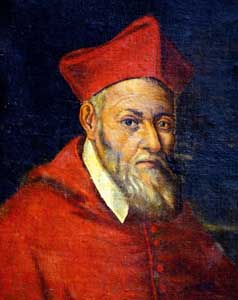
Tolomeo Gallio was an Italian Cardinal.

Pietro Ostini was an Italian papal diplomat and Cardinal.
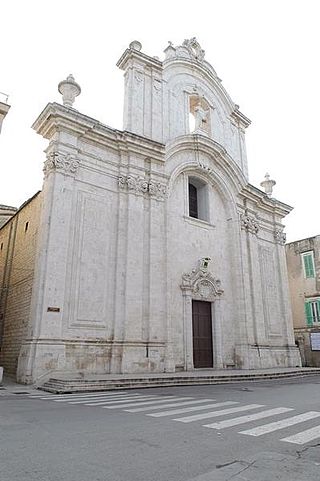
The Diocese of Molfetta-Ruvo-Giovinazzo-Terlizzi is a Latin diocese of the Catholic Church in Apulia, southern Italy, which was established in 1986, when the diocese of Molfetta-Giovinazzo-Terlizzi was united with the diocese of Ruvo. Giovinazzo is only four miles south-east of Molfetta along the Adriatic coast, and Ruvo only ten miles inland to the south-west; Terlizzi is likewise only four miles from Molfetta, some four miles nearer than Ruvo. The historical diocese of Molfetta was expanded in 1818. The current diocese is a suffragan of the archdiocese of Bari-Bitonto.
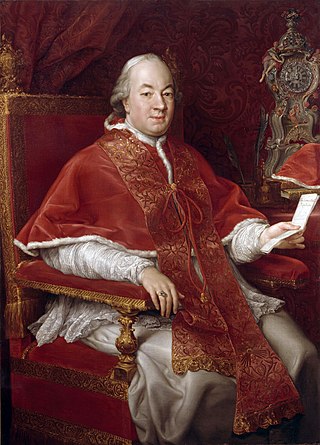
The 1774–75 papal conclave, was convoked after the death of Pope Clement XIV and ended with the election of Cardinal Giovanni Angelo Braschi, who took the name of Pius VI.

Benedetto Barberini was a Catholic Cardinal and Camerlengo of the Sacred College of Cardinals.

Alderano Cybo was an Italian Catholic Cardinal. He served as the Secretary of State of Pope Innocent XI.

Giuseppe Renato Imperiali was an Italian cardinal, and known as an avid bibliophile.
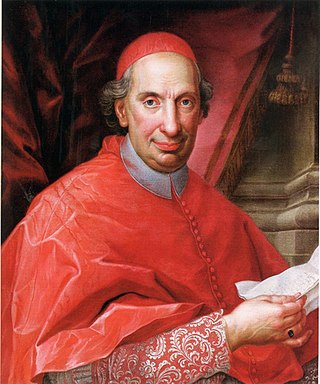
Antonio Banchieri was an Italian cardinal.
The Holy Congregation of the Vatican Press was an organ of the Roman Curia.
Francesco Ravizza was an Italian archbishop and diplomat, Apostolic Nuncio to Portugal from 1670 to 1673.

















